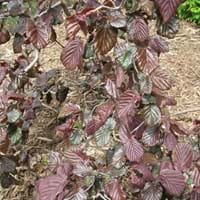Life Span
Perennial
Annual
Origin
Hybrid origin, Mexico, Central America, South America
Europe, Northern Africa, Western Asia
Types
Not Available
Shrub
Habitat
Coastal Regions
Woods
USDA Hardiness Zone
11-15
4-8
Sunset Zone
A1, A2, A3, H1, H2, 1a, 1b, 2a, 2b, 3a, 3b, 4, 5, 6, 7, 8, 9, 10, 11, 12, 13, 14, 15, 16, 17, 18, 19, 20, 21, 22, 23, 24
2a, 2b, 3a, 3b, 4, 5, 6, 7, 8, 9, 14, 15, 16, 17, 18, 19, 20
Habit
Upright/Erect
Thicket/Colonizing
Flower Color
Yellow
Yellow
Flower Color Modifier
Bicolor
Not Available
Leaf Color in Spring
Green, Dark Green
Green
Leaf Color in Summer
Green, Dark Green
Green, Dark Green
Leaf Color in Fall
Green, Dark Green
Yellow, Green
Leaf Color in Winter
Green, Dark Green
Not Available
Plant Season
Spring, Summer, Fall
Spring, Summer, Fall, Winter
Sunlight
Full Sun
Full Sun, Partial Sun, Partial shade
Type of Soil
Loam, Sand
Clay, Loam, Sand
The pH of Soil
Neutral
Acidic, Neutral, Alkaline
Soil Drainage
Well drained
Well drained
Bloom Time
Indeterminate
Early Spring, Spring, Late Winter
Tolerances
Drought
Not Available
Where to Plant?
Container, Ground
Ground, Pot
How to Plant?
Grafting, Seedlings
Grafting
Plant Maintenance
Medium
Medium
Watering Requirements
Needs more water during establishment
Average Water Needs, Do Not over Water
In Summer
Lots of watering
Lots of watering
In Spring
Moderate
Moderate
In Winter
Average Water
Average Water
Soil pH
Neutral
Acidic, Neutral, Alkaline
Soil Type
Loam, Sand
Clay, Loam, Sand
Soil Drainage Capacity
Well drained
Well drained
Sun Exposure
Full Sun
Full Sun, Partial Sun, Partial shade
Pruning
Pinch or prune as they grow to promote branching and bushiness
Remove damaged leaves, Remove dead branches, Remove dead leaves
Fertilizers
14-14-14 Fertilizer, Compost
All-Purpose Liquid Fertilizer
Pests and Diseases
Anthracnose, Aphids, Red blotch, Rust
Red blotch
Plant Tolerance
Heat Tolerance, Salt and Soil Compaction
Drought
Flower Petal Number
Single
Not Available
Fragrant Bark/Stem
Yes
No
Foliage Texture
Medium
Coarse
Foliage Sheen
Matte
Matte
Attracts
Aphids, Not Available, Squirrels
Not Available
Allergy
Stomach pain, Vomiting
Not Available
Aesthetic Uses
Used in parkland
Showy Purposes
Beauty Benefits
Anti-ageing, Blackheads, Reduce Bruises
Not Available
Environmental Uses
Shadow Tree, Soil protection
Air purification
Medicinal Uses
Dehydration, Diabetes, Diarrhea, Nutrients, Weight loss
Minerals, Rich in protein, tonic in pregnancy, Vitamin E
Part of Plant Used
Fruits
Fruits, Leaves, Seeds, Wood
Other Uses
Application in Handicrafts, Food for animals, Showy Purposes
Culinary use, Used for its medicinal properties
Used As Indoor Plant
No
No
Used As Outdoor Plant
Yes
Yes
Garden Design
Edible, Herb, Vegetable
Feature Plant, Foundation, Mixed Border, Topiary, Bonsai, Espalier
Botanical Name
Manilkara zapota
CORYLUS avellana 'Contorta'
Common Name
sapodilla , chikoo, Sapota
common hazel
In Hindi
चीकू
contorted filbert
In German
Breiapfelbaum
contorted filbert
In French
Sapotillier
noisetier contorsionné
In Spanish
chicle
avellana contorsionada
In Greek
sapodilla
παραμορφωμένες φουντουκιού
In Portuguese
sapodilla
filbert contorcido
In Polish
Pigwica właściwa, sapodilla
wykrzywioną leszczyna
In Latin
sapodilla
contortis Avellanam
Phylum
Magnoliophyta
Magnoliophyta
Class
Magnoliopsida
Magnoliopsida
Family
Sapotaceae
Betulaceae
Clade
Angiosperms, Asterids, Eudicots
Angiosperms, Eudicots, Rosids
Tribe
Sapoteae
Not Available
Subfamily
Sapotoideae
Not Available
Number of Species
Not Available
Season and Care of Sapodilla and Contorted Filbert
Season and care of Sapodilla and Contorted Filbert is important to know. While considering everything about Sapodilla and Contorted Filbert Care, growing season is an essential factor. Sapodilla season is Spring, Summer and Fall and Contorted Filbert season is Spring, Summer and Fall. The type of soil for Sapodilla is Loam, Sand and for Contorted Filbert is Clay, Loam, Sand while the PH of soil for Sapodilla is Neutral and for Contorted Filbert is Acidic, Neutral, Alkaline.
Sapodilla and Contorted Filbert Physical Information
Sapodilla and Contorted Filbert physical information is very important for comparison. Sapodilla height is 150.00 cm and width 60.00 cm whereas Contorted Filbert height is 180.00 cm and width 180.00 cm. The color specification of Sapodilla and Contorted Filbert are as follows:
Sapodilla flower color: Yellow
Sapodilla leaf color: Green and Dark Green
Contorted Filbert flower color: Yellow
- Contorted Filbert leaf color: Green
Care of Sapodilla and Contorted Filbert
Care of Sapodilla and Contorted Filbert include pruning, fertilizers, watering etc. Sapodilla pruning is done Pinch or prune as they grow to promote branching and bushiness and Contorted Filbert pruning is done Remove damaged leaves, Remove dead branches and Remove dead leaves. In summer Sapodilla needs Lots of watering and in winter, it needs Average Water. Whereas, in summer Contorted Filbert needs Lots of watering and in winter, it needs Average Water.





